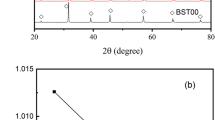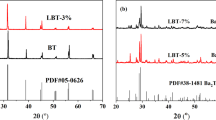Abstract
As a temperature self-regulating heater material, the doped BaTiO3 exhibits an attractive application perspective in the thermal management of electrical devices. However, the high Curie temperature does not meet the requirement in the thermal control application. In this work, (Ba0.997−xCe0.003Srx)(TiNb0.002)O3 (x=0.2, 0.3, 0.35, abbreviated as BCSTNs) ceramics were prepared by the solid-state reaction method. The purpose of doping different content of strontium is to shift the Curie temperature of BaTiO3-based ceramic to the ambient temperature region, maintaining excellent PTC effect and low room-temperature resistivity by codoped cation ions in Ba- and Ti-site. The influences of sintering temperature and soak time on the microstructure as well as electrical properties of BCSTNs ceramics have been studied. The X-ray diffraction reveals that the composition with x=0.35 exhibits the coexistence of tetragonal and cubic lattice symmetries, confirmed by the Rietveld structure refinement. The dense microstructure with average grain sizes 0.84–7.87 μm was observed for BCSTN ceramics. Temperature-resistivity measurements demonstrate that TC of the ceramics with x=0.35 shifted to the room temperature region. Additionally, the BCSTN ceramic with heavy doping Sr exhibits relative low room-temperature resistivity and the resistance jump greater than 2.0 orders of magnitude.
Similar content being viewed by others
References
Liu J, Li Y Z, Chang J, et al. A review of small satellite thermalcontrol system (in Chinese). Spacecr Environ Eng, 2011, 28: 77–82
Dudon J P, Zaradzki C, Paul-Bert P, et al. Flexible self-regulating heater (FSRH) using PTC effect: A promising technology for future spacecraft thermal control. In: 46th International Conference on Environmental Systems. Vienna, 2016. 1–10
Cheng W, Yuan S, Song J. Studies on preparation and adaptive thermal control performance of novel PTC (positive temperature coefficient) materials with controllable Curie temperatures. Energy, 2014, 74: 447–454
Song J, Cheng W, Xu Z, et al. Study on PID temperature control performance of a novel PTC material with room temperature Curie point. Int J Heat Mass Transfer, 2016, 95: 1038–1046
Cheng W, Song J, Liu Y, et al. Theoretical and experimental studies on thermal control by using a novel PTC material with room temperature Curie point. Int J Heat Mass Transfer, 2014, 74: 441–447
Li Y Z, Wei C F, Yuan L S. Simulation study of satellite partial temperature control system using PTC heater (in Chinese). J Syst Simul, 2005, 17: 1494–1496
Hill D, Tuller H. Ceramic sensors: Theory and practise. In: Buchanan R, Ed. Ceramic Materials for Electronics. NY: Marcel Dekker Inc., 1991. 335
Hozer L. Positive temperature coefficient of resistivity (PTCR) thermistors. In: Semiconductor Ceramics, Grain Boundary Effects. Ellis Horwood Series in Physics and its Applications. Poland, 1994. 109–147
Heywang W. Bariumtitanat als sperrschichthalbleiter. Solid-State Electron, 1961, 3: 51–58
Urek S, Drofenik M, Makovec D. Sintering and properties of highly donor-doped barium titanate ceramics. J Mater Sci, 2000, 35: 895–901
Mancini M W, Filho P I P. Direct observation of potential barriers in semiconducting barium titanate by electric force microscopy. J Appl Phys, 2006, 100: 104501
Yang M, Peng Z, Wang C, et al. Microstructure and electrical properties of BaTiO3-(Bi0.5M0.5)TiO3 (M=Li, Na, K, Rb) ceramics with positive temperature coefficient of resistivity. Ceram Int, 2016, 42: 17792–17797
Liu M, Qu Y, Yang D. Effect of Bi2O3 doping methods on the positive temperature coefficient property of Ba0.999(Bi0.5Na0.5)0.001TiO3 ceramics. J Alloys Compd, 2010, 503: 237–241
Al-Allak H M. Anomalous increase in the resistivity of n-doped Ba-TiO3-based ceramics with pressure observed at room temperature. J Am Ceram Soc, 2011, 94: 2757–2760
Ding S W, Jia G, Wang J, et al. Electrical properties of Y-and Mn-doped BaTiO3-based PTC ceramics. Ceram Int, 2008, 34: 2007–2010
Qi J, Gui Z, Wu Y, et al. Enhancement of PTCR effect of semiconducting Ba1−xSrxTiO3 by Sb2O3 vapor. Sensor Actuat A-Phys, 2001, 93: 84–85
Wegmann M, Brönnimann R, Clemens F, et al. Barium titanate-based PTCR thermistor fibers: Processing and properties. Sensor Actuat APhys, 2007, 135: 394–404
Yu L H, Xue Q Z, Zhang D M. On a sudden-changing PTC material with low curie point (in Chinese). Electron Compon Mater, 1994, 13: 14–16
Patil D R, Lokare S A, Devan R S, et al. Studies on electrical and dielectric properties of Ba1−xSrxTiO3. Mater Chem Phys, 2007, 104: 254–257
Jiang S L, Gong S P, Zhou L, et al. Study on the co-doped BaTiO3 semiconducting ceramic (in Chinese). Piezoelec acousto-optic, 2000, 22: 392–394
He Z, Ma J, Qu Y, et al. Effect of additives on the electrical properties of a (Ba0.92Sr0.08)TiO3-based positive temperature coefficient resistor. J Eur Ceramic Soc, 2002, 22: 2143–2148
He Z, Ma J, Qu Y, et al. Compositional and processing effects on electrical properties of (Ba0.85Pb0.15)TiO3-based positive temperature coefficient resistors. J Eur Ceramic Soc, 2004, 24: 3617–3622
Nemati Z A, Tabibazar M, Deguire M R. The effects of cerium doping on the resistivity of PTCR barium lead titanate. Br Ceram Trans, 1993, 92: 109–113
Cernea M, Monnereau O, Llewellyn P, et al. Sol-gel synthesis and characterization of Ce doped-BaTiO3. J Eur Ceramic Soc, 2006, 26: 3241–3246
Ianculescu A, Pintilie I, Vasilescu C A, et al. Intrinsic pyroelectric properties of thick, coarse grained Ba1−xSrxTiO3 ceramics. Ceram Int, 2016, 42: 10338–10348
Chen Y L, Yang S F. PTCR effect in donor doped barium titanate: Review of compositions, microstructures, processing and properties. Adv Appl Ceramics, 2011, 110: 257–269
Heywang W. Resistivity anomaly in doped barium titanate. J Am Ceramic Soc, 1964, 47: 484–490
Jonker G H. Some aspects of semiconducting barium titanate. Solid-State Electron, 1964, 7: 895–903
Kuwabara M, Matsuda H, Kurata N, et al. Shift of the curie point of barium titanate ceramics with sintering temperature. J Am Ceramic Soc, 1997, 80: 2590–2596
Kim J G. Sintering condition and PTCR characteristics of porous n-BaTiO3 ceramics by adding poly(ethylene glycol). J Mater Sci, 2004, 39: 6129–6131
Kim J G, Ha J G, Lim T W, et al. Preparation of porous BaTiO3-based ceramics by high-energy ball-milling process. Mater Lett, 2006, 60: 1505–1508
Brzozowski E, Castro M S. Influence of Nb5+ and Sb3+ dopants on the defect profile, PTCR effect and GBBL characteristics of BaTiO3 ceramics. J Eur Ceramic Soc, 2004, 24: 2499–2507
Cheng X, Li X, Chen G, et al. Influence of sintering method on the PTCR effect and microstructures of Sm2O3-doped BaTiO3-based ceramics sintered in a reducing atmosphere. Ceramics Int, 2017, 43: S249–S252
Huybrechts B, Ishizaki K, Takata M. Influence of high oxygen partial pressure annealing on the positive temperature coefficient of Mn-doped Ba0.8Sr0.2TiO3. J Eur Ceramic Soc, 1993, 11: 395–400
Daniels J, Wernicke R, Part V. News aspects for an improved PTCR model. Philips Res Rept, 1976, 31: 544–559
Daniels J, Haerdtl K H, Wernicke R. The PTC effect of barium titanate. Philips Technical Review, 1976, 38: 73–82
Kutty T R N, Murugaraj P, Gajbhiye N S. Activation of trap centres in PTC BaTiO3. Mater Lett, 1984, 2: 396–400
Chen Y, Gong S, Zhang B, et al. The preparation of fine-grained positive temperature coefficient resistance with superior electrical properties. Microelectron Eng, 2013, 103: 106–110
Author information
Authors and Affiliations
Corresponding author
Rights and permissions
About this article
Cite this article
Yu, A., Li, Q., Fan, D. et al. Study on positive temperature coefficient of resistivity of co-doped BaTiO3 with Curie temperature in room temperature region. Sci. China Technol. Sci. 62, 811–819 (2019). https://doi.org/10.1007/s11431-018-9435-7
Received:
Accepted:
Published:
Issue Date:
DOI: https://doi.org/10.1007/s11431-018-9435-7




